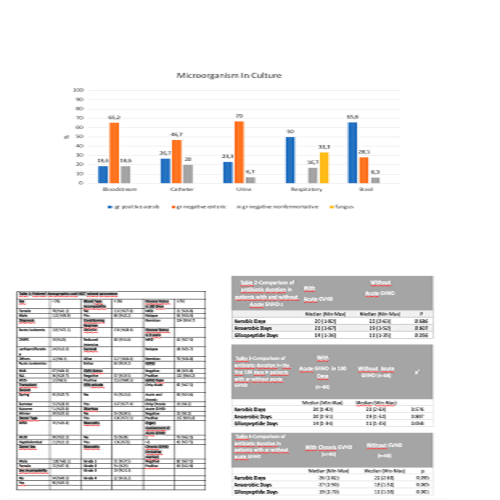
Contributions
Abstract: EP1283
Type: E-Poster Presentation
Session title: Stem cell transplantation - Clinical
Background
The microbiome is a hot topic in recent years. It is severely disrupted by the antimicrobials during Allogeneic Hematopoietic Stem Cell Transplantation (AHSCT), resulting in a change in outcome.
Aims
This study evaluates the relationship between the usage of antibiotics with different spectrums in the first 100 days of AHSCT and GVHD incidence.
Methods
190 patients who underwent AHSCT between March 2015 and January 2020 were retrospectively evaluated. Patients demographics and pretransplant features are shown in table-1. The antibiotics were grouped into three according to the spectrum of action: 1 -Aerobic (Levofloxacin, ciprofloxacin, amikacin, colistin, amoxicillin moxifloxacin); 2-Anaerobic (piperacillin-tazobactam, meropenem, imipenem, metronidazole, tigecycline, fosfomycin, linezolid); 3-Gram+tives (teicoplanin, vancomycin, moxifloxacin). All the patients received the same antimicrobial prophylaxis.
Results
Among the 190 patients, n=122(64.2%) developed GVHD.
The development of AGVHD in the first 100 days and one year is median 37 days (9-100) and 148.5 days (103-360), respectively. The development of chronic GVHD( including overlaps) is median six months (2-16 months). There was no difference in terms of documented microorganisms in patients with or without GVHD. In figure 1, we show the documented microorganisms in the culture in 100 days. The relationship between the duration of antibiotic usage and the development of GVHD is shown in tables 2, 3, 4. There was no relationship between the involvement of different organ GVHD, underlying diseases, and antibiotic groups. However, AHSCT from a match-related donor (MRD) had shorter usage of anti-aerobic antibiotics than match unrelated (MUD) and haploidentical donor; p=0.02, and p=0.014 respectively. However, anti-anaerobic duration was shorter in MRD compared with haploidentical donors (p=0.02) but not with MUD or MUD vs. haplo. Glycopeptide duration was longer in haploidentical donors than MRD and MUD, P=0.017 and p=0.018, respectively.
In the multivariate logistic regression analysis, patients who developed chronic GVHD had more prolonged glycopeptide usage (p<0.001). The threshold for chronic GVHD development is >14.5 days, the risk increase by 6.7 times.

Conclusion
Many parameters can affect the outcome of HSCT. As a consequence of this study, the antibiotic's spectrum should also be considered in terms of GVHD, particularly in haploidentical transplantations.
Keyword(s): Allogeneic hematopoietic stem cell transplant, Graft-versus-host disease (GVHD)
Abstract: EP1283
Type: E-Poster Presentation
Session title: Stem cell transplantation - Clinical
Background
The microbiome is a hot topic in recent years. It is severely disrupted by the antimicrobials during Allogeneic Hematopoietic Stem Cell Transplantation (AHSCT), resulting in a change in outcome.
Aims
This study evaluates the relationship between the usage of antibiotics with different spectrums in the first 100 days of AHSCT and GVHD incidence.
Methods
190 patients who underwent AHSCT between March 2015 and January 2020 were retrospectively evaluated. Patients demographics and pretransplant features are shown in table-1. The antibiotics were grouped into three according to the spectrum of action: 1 -Aerobic (Levofloxacin, ciprofloxacin, amikacin, colistin, amoxicillin moxifloxacin); 2-Anaerobic (piperacillin-tazobactam, meropenem, imipenem, metronidazole, tigecycline, fosfomycin, linezolid); 3-Gram+tives (teicoplanin, vancomycin, moxifloxacin). All the patients received the same antimicrobial prophylaxis.
Results
Among the 190 patients, n=122(64.2%) developed GVHD.
The development of AGVHD in the first 100 days and one year is median 37 days (9-100) and 148.5 days (103-360), respectively. The development of chronic GVHD( including overlaps) is median six months (2-16 months). There was no difference in terms of documented microorganisms in patients with or without GVHD. In figure 1, we show the documented microorganisms in the culture in 100 days. The relationship between the duration of antibiotic usage and the development of GVHD is shown in tables 2, 3, 4. There was no relationship between the involvement of different organ GVHD, underlying diseases, and antibiotic groups. However, AHSCT from a match-related donor (MRD) had shorter usage of anti-aerobic antibiotics than match unrelated (MUD) and haploidentical donor; p=0.02, and p=0.014 respectively. However, anti-anaerobic duration was shorter in MRD compared with haploidentical donors (p=0.02) but not with MUD or MUD vs. haplo. Glycopeptide duration was longer in haploidentical donors than MRD and MUD, P=0.017 and p=0.018, respectively.
In the multivariate logistic regression analysis, patients who developed chronic GVHD had more prolonged glycopeptide usage (p<0.001). The threshold for chronic GVHD development is >14.5 days, the risk increase by 6.7 times.

Conclusion
Many parameters can affect the outcome of HSCT. As a consequence of this study, the antibiotic's spectrum should also be considered in terms of GVHD, particularly in haploidentical transplantations.
Keyword(s): Allogeneic hematopoietic stem cell transplant, Graft-versus-host disease (GVHD)


